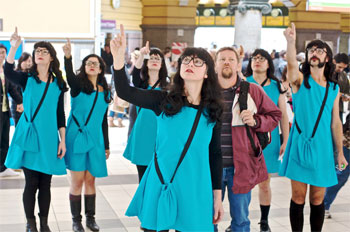The Melbourne Fringe Festival is a rambling affair, with ‘open-entry’ to all ‘creative types’, largely non-discerning in the projects it includes and encompassing a vast array of the expressive forms we call ‘the arts’. The venues are as varied and unpredictable as the shows, they may be in one of the ‘festival hubs’ such as The Lithuanian Club or The North Melbourne Town Hall, in a ‘home theatre’ set up in a kitchen, or a ‘traveling performance’, taking you by surprise as you commute via tram. The festival is also a time to ponder the implications of an ever-broadening ‘art scene’ in Melbourne for the plight of independent expression.
The Festival has aligned itself with frequently used Melbourne cultural catch phrases such as “edgy”, “innovative” “independent”, “emerging” art. We are – and we are constantly reminded of this – a city that “loves our art”. The sections branded as ‘arts and culture’ in our mainstream newspapers remain prominent, testament to the revenue created by these industries, even if the ‘big earners’, the blockbuster musicals such as Wicked are more closely tied to their corporate counterparts than any artistic community and are anything but “edgy” or “innovative”. However, since ‘art’ is not something that traditionally originates amongst corporate ventures, something that used to speak of the struggle to understand and make sense of society by artists who were often disenfranchised by the mainstream, it is important that Melbourne be seen as accommodating its “emergent”, “edgy” “deviant” artists. Also, as free consumers, it is only right that we be allowed to indulge our individual tastes, be they ‘Mumma Mia, The Musical’ or “independent”, “small scale” art.
Events like The Fringe Festival, apart from creating the semblance of democratically facilitating diversity within the arts, obviously serve as a great opportunity for various PR ventures, such as Metlink, (formerly Connex) who have jumped on the Fringe wagon this year. PR on their website employs artistic jargon to boast of Metlinks “parternership” with the Fringe.
“Metlink CEO Bernie Carolan said that the partnership with Fringe was an opportunity to promote the benefits of catching public transport to Melbourne’s major events.”…. “By teaming up with the Melbourne Fringe Festival we turned the public transport network into the stage for part of this unique performance”. ~ Metlink website
This tedious piece of culture-devouring PR is typical of what has become the ‘Melbourne’ advertising montage, a jumble of projects that feed off the ‘city’s’ profile as a cultural hub, see the government sponsored “that’s Melbourne city” website. Interestingly, the performance Metlink champions, “by Japanese artist, Yasuko Kurono” features the symbolic imagery of “clones”.
Have our independents become cloned images of their former selves, sponsored by the very private systems that thrive off an ideology essentially hostile to independence and expression in its true sense? (See article tagged under ‘space’ on this blog) When private companies parade the fruits of their cultural co-ventures we must question the very meaning of ‘independent’ again.
What does the homogenization of established and ‘emerging’ art under the same Melbourne ‘cultural’ banner mean for the lauded notion of an ‘independent artist’, or an independent anything for that matter? Whilst corporate sponsorship of the arts increases, corporate annexing of our education system erodes the departments in which the arts are fostered. A case in point is the moves to transform Melbourne’s VCA (Victorian College of The Arts), amalgamating its programs into a larger Melbourne University model, dictated by corporate interests.
When you go along to a Fringe show, you cannot help but be moved by the time and energy obviously invested in the work, often individually, lovingly curated; small scale but impressively accomplished. Many of the artists have been preparing their Fringe pieces for the past year, and hope to make themselves known to audiences, bettering their positions for their own ‘independent’ practice. Many of the Fringe artists I have spoken to cannot afford to purchase tickets on Melbourne Private transport.
Links to explore:
Melbourne Fringe Festival Home
Background and Coverage of VCA proposed curriculum changes
Geoffrey Rush joins VCA protest – ABC
Ex-ministers protest against VCA merger – ABC







